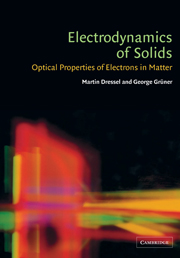11 - Measurement configurations
Published online by Cambridge University Press: 20 May 2010
Summary
The configurations which guide the electromagnetic radiation and allow the interaction of light with matter vary considerably, with a wide variation of techniques developed over the years and employed today. We can distinguish between single-path and interferometric arrangements, and – as far as the interaction of light with the material under study is concerned – single-bounce from multiple-bounce, so-called resonant techniques. In this chapter we present a short summary.
Single-path arrangements sample the change of the electromagnetic wave if only one interaction with matter takes place; for instance if the light is reflected off the sample surface or is transmitted through the specimen in a single path. In general, part of the radiation is absorbed, and from this the optical properties of the material can be evaluated. However, only at low frequencies (i.e. at long wavelengths) does this simple configuration allow the determination of the phase change of the radiation due to the interaction; for higher frequencies only the attenuation in power is observed.
Interferometric techniques compare one part of the radiation, which undergoes the interaction with the material (i.e. reflection from or transmission through the material), with a second part of the signal, which serves as a reference. In this comparative approach – the so-called bridge configuration – the mutual coherence of the two beams is crucial. The interference of the two beams is sensitive to both the change in amplitude and in phase upon interaction, and thus allows calculation of the complex response of the specimen.
Information
- Type
- Chapter
- Information
- Electrodynamics of SolidsOptical Properties of Electrons in Matter, pp. 269 - 298Publisher: Cambridge University PressPrint publication year: 2002
